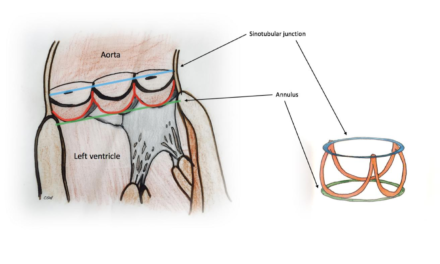Welcome to the monthly SHDA Research Update. Our specialists have selected 3 seminal papers that have been recently published in each speciality.
Quick Links
Perioperative Medicine
Summarised by Sarah Catchpoole
An essential summary for anaesthetists and perioperative physicians of the most important changes and information from the 2014 ACC/AHA Guidelines for the management of patients with valvular heart disease. Included in the summary are the major valvular diseases, and considerations for antithrombotic therapy and bridging therapy.
General anaesthesia and endotracheal intubation has increasingly been omitted from TAVI, and thus standard TEE monitoring replaced with angiographic/fluoroscopic guidance and intermittent TTE as a compromise, which has several limitations. This review proposes intracardiac echocardiography (ICE) as a solution especially for high-risk patients, with full discussion of benefits, limitations and clinical use.
Candidates for TAVI with severe AS often have pulmonary hypertension (PH), which may be monitored to detect intra-interventional deterioration and is an independent predictor of post-surgical prognosis and mortality. Conventional monitoring of pulmonary artery pressure (PAP) is via echocardiography or the gold standard, right heart catheterisation (RHC). This is the first study to use intracardiac Doppler echocardiography (ICDE) to assess PAP immediately before and after TAVR in 114 consecutive high-risk patients. Muller et al. found ICDE feasible, reliable, and valid during transfemoral, transapical, and transaortal approaches, and suggest it could replace RHC for PAP monitoring.
Cardiac Imaging
Summarised by Sarah Catchpoole
Mangold et al. Imaging in Minimally Invasive Mitral Valve Repair. J Thorac Imaging. 2015 Aug
An expert review of imaging for mitral valve repair and replacement, with special emphasis on the role of coronary computed tomography (CCT) and cardiac magnetic resonance imaging (CMR). CCT has high resolution, fast scanning time, and is best used in pre-procedural planning for MV anatomic assessment and device sizing. CMR however is most useful in assessing risk of adverse outcomes and for ongoing monitoring and follow up.
Systolic increased left ventricular apical rotation has been observed in patients with severe aortic stenosis (AS), but the clinical relevance is unknown. In a retrospective analysis of 82 patients with severe AS (LVEF ≥50%), patients were grouped into high apical rotation (n=41) and low apical rotation (n=42) on the basis of speckle-tracking echocardiography. High apical rotation was associated with smaller indexed aortic valve areas, increased valvuloarterial impedance, lower overall survival, but less syncope. The authors suggest increased left ventricular apical rotation may represent a compensatory mechanism to preserve cardiac output against obstruction.
The interesting case study of a 53 year old male presenting with acute LV failure, with a family history of spontaneous pulmonary artery rupture in the mother at age 42. Subsequent imaging demonstrated an aberrant RCA originating from the main pulmonary artery with collateral supply from the left circumflex. There was an aneurysm in the proximal RCA communicating via a fistula with an aneurysm of the proximal LAD, and severe LV dilatation and impairment. The man underwent successful surgery and remains well at one year follow up.
Cardiology
Summarised by Sarah Catchpoole
Herman et al. identified 77 patients from a registry with documented progression from non-severe to severe aortic stenosis (AS) by transthoracic echocardiographic examinations performed at least 6 months apart. The patients were grouped retrospectively into high-gradient AS, low-gradient AS, and further low-gradient subgroups. Overall, the authors conclude that the natural history of high-gradient AS is one of faster progression and earlier valve replacement. In contrast, while low gradient AS has slower progression, it should be considered a more systemic disease, with worse clinical outcomes and requiring a broader approach to treatment. The authors suggest early stratification of non-severe AS is possible and clinically important.
Direct Factor Xa inhibitor andexanet has demonstrated both efficacy and safety in this phase of the ANNEXA-A and ANNEXA-R trials. In healthy older volunteers, bolus administration reversed the anticoagulant effects of apixaban and rivaroxaban within 2-5 minutes, without serious adverse clinical events. The effects were sustained if administration continued as an infusion.
NEJM Summary Video
Andexanet Alfa Mechanism of Action Video
https://www.youtube.com/watch?v=LXA7aIAA7yQ
In the first human trial of a novel self-expanding transcatheter heart valve (BIOVALVE), device success was achieved in 9 out of 13 enrolled patients. Re-sheathing was performed in 5 patients. At 30 day follow up, NYHA class had improved in 7 patients, and echocardiographic parameters of valve function were overall good. The overall 30 day complication rate was low (1 valve-invalve procedure, 1 episode of life-threatening bleeding, 1 hospitalisation for congestive heart failure, and 3 patients requiring pacemaker implantation) with no death or other major complications. The authors conclude the BIOVALVE system has here demonstrated feasibility and safety, although further studies will be required.
Cardiothoracic Surgery
Summarised by Andrew Haymet
Decision making processes under routine conditions by “Heart Teams” involving patients eligible for either surgical aortic valve replacement (AVR) or transcatheter aortic valve implantation (TAVI) remain poorly understood. A non-randomised prospective clinical trial of 124 patients was used to retrospectively replicate the decision making process. Two year survival rates of 75% were observed irrespective of AVR or TAVI treatment, suggesting decisions made by the “Heart Team” were appropriate.
The presence of a redundant Eustachian Valve (EV) can be difficult to distinguish from a double atrial septum (DAS). The former is generally anterior, whilst the latter tends to be posteriorly and to the left of the inferior vena cava. A percutaneous closure technique of an atrial septal defect (ASD) is described in a patient in whom a transoesophageal echocardiography (TOE) showed a possible, yet undetected DAS. An RV pigtail catheter was found to be particularly useful to avoid tissue interference during ASD occlusion, and to differentiate between anatomical variations.


















